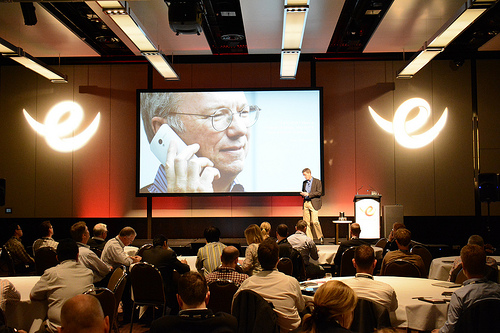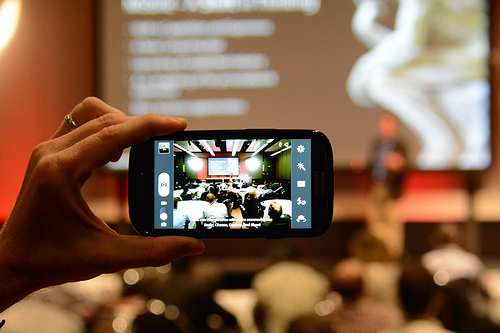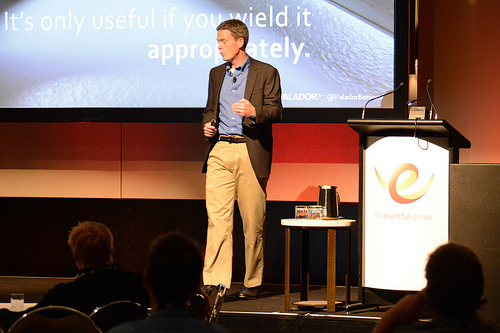Just a few shots from the Mastering Mobility conference in Melbourne Australia. It was a lot of fun to have the opportunity to deliver the opening keynote on mobile strategy. Big thanks to the folks at the Eventful Group for putting on such a great event!
Tag Archives: Mobile Strategy
Mobile Has to Matter
This article was originally published on Sept 3 2011 on HP’s September issue of Discover Performance
Mobile influencer Benjamin Robbins describes how enterprises can approach mobility to improve the enterprise, revitalize IT, and, most importantly, serve the user. There isn’t an enterprise on the planet today that doesn’t recognize the value of mobility—not just to customers but also to employees. But mobile has emerged as such an important way of transacting business that some organizations get psyched out when they try to define their approach it. We spoke with Benjamin Robbins, co-founder of enterprise mobility consultancy Palador, on how enterprises should think about mobile and the role that IT leadership can play in a self-service world of cloud and automation. Perhaps surprisingly, he said that, in some ways, mobile is no big deal.
Q: How do most enterprises view mobile? How does that contrast with how they should view mobile?
Benjamin Robbins: Companies should not look at mobile as a separate, siloed piece of technology. Mobile should, at its core, support the company’s objectives. Companies don’t have a laptop strategy or a PC strategy. Mobile is no different—it’s just a technology that needs to support the business. The way to avoid that is to always ask why. Why are we doing this? How does it support whatever aspect of the business we want to support? How does it help move us forward?
Q: Why do most enterprises have a hard time seeing mobile as just another tool in the toolbox?
BR: People get excited and think of it as special because anytime, anywhere connectivity to apps and services is a different compute paradigm. When you’re at a client site, you used to say, “I can send you that file when I get back to the office.” But mobile shortens the cycle. Whenever there’s a need, the ability to execute is much shorter. That’s exciting for organizations, but they have to stick to the core mission and ensure that mobility supports those core business processes.
Q: Where are enterprises messing up mobility?
BR: They’re tripping up in a few areas. First, there’s the traditional way of doing IT that has a really PC-centric sense of things like security and network. But now you have people bringing their own devices to work, and IT doesn’t always want to make the shift to handle it. Second, employees can now be their own IT. Everybody doesn’t have to have the same app—maybe you like QuickOffice, maybe I like something else—and IT doesn’t intuitively know how to handle that. Third, the whole idea of “network” is changing. Network used to be a physically bounded thing you had to plug into. All of that is changing, and organizations are tripping up because the mentality of IT isn’t changing.
Q: That seems like an issue for IT leadership.
BR: Yes, I think enterprises need to get to a place where IT leadership understands that IT’s role is changing but it’s not being eliminated. Business units have the knowledge and budget to drive services they need. However, they lack the technical heft. IT’s role is to enable those services, guide those services, understand existing capabilities in the marketplace, and play a support role in implementation. Business units don’t normally have the expertise to manage those things long term, so they need a partnership with IT. You really need IT leaders who don’t view their primary job function as cost cutting. It’s got to be about enabling people, not saving money.
Q: How does a visionary IT leader get the CIO and CFO to agree that cutting costs, or languishing with flat budgets, is not the way to manage IT?
BR: It is very simple. It involves the right attitude combined with the right metrics. First, organizations need a CIO and CFO who understand that there is a shift taking place, where technology is first being approached as an operational expense rather than a capital expense. Businesses need to exit the business of owning technology and spend the cycles instead on figuring out how services will advance the core business. This eliminates the attitude of treating technology as just another utility to be managed, like electricity or garbage. Second, as with any technical project, the “why” must be tied to ROI. CIOs should be able to answer how any project, be it mobile or not, advances the mission of the organization, and what sort of metrics are being used to measure the success of the investment. Mobile in no way should eliminate the need for fiduciary responsibility. The CIO should have no trouble drawing a line between technical budgets and organizational need.
Q: What kind of expertise will IT bring to the table, now that the business can generally help itself to the services it needs?
BR: The BUs get really excited about something, but might not see the bigger picture. One BU might get super-excited about a service and dump a bunch of data into it, and use it for a year before realizing it’s not what they need. Then they have to get that data out and don’t know how. IT can help with that—and help prevent that from happening in the first place. Plus, you need people who can go deep into the data. Data streams are at the core of business value, so it’s imperative to have people who can manipulate and manage data beyond an Excel level of expertise.
Q: You spent a full year working only on a mobile device. What were the biggest insights you gleaned that might be helpful to enterprises working on a mobile strategy?
BR: I think that organizations, as part of their mobile policy, should advocate that it’s really important to maintain a healthy connected balance. If you say “we don’t need mobile,” you’ll fail, because competition will fly by you and you won’t know what happened. But by the same token, if you expect people to be connected 24/7, you’ll burn people out, and the organization will suffer, too. If you send someone an email, does it really matter that they get back to you in two minutes vs. two hours? The important thing about mobile isn’t making people use it all the time—it’s using it in the right instances. Here’s an example. There’s a medical device company and their sales team had to get in front of surgeons. They found that with mobile devices, they could get right in front of surgeons while they’re scrubbing up for the next surgery. You couldn’t do that with computers, but with a tablet you can do that. A mobile strategy shouldn’t be about being constantly connected; it should be about using the technology in the right way at the right time.
Get more from Benjamin Robbins on Twitter at @PaladorBenjamin and at Palador.com.
Stop Wasting Your Time with Mobile
I hate receipts. Not just hate them, I loathe them. They are nothing more than pocket clutter—an anachronistic holdover from an analog age that I can’t wait to disappear. I can envision myriad ways that mobility can improve upon the lowly paper receipt. Electronic payment seems like the obvious answer. Simply walk up to the register, tap/scan, sign, and you are done. No fuss, no muss, and most importantly, no receipt. But, as much as I detest receipts, the current experience of electronic payment is massively underutilizing the platform’s potential. It is akin to using a tower crane to pick up a penny. Mobility must drastically alter the experience or it risks being a waste of time and resources.
I live in Seattle, home of the famed coffee juggernaut Starbucks. Here you can find a Starbucks coffee shop on every corner in downtown, and sometimes two or three. So I was pleased when I learned that Starbucks was partnering with Square Wallet to accept mobile payments. I thought my afternoon coffee experience was going to leap into the future. After the much-publicized bumps in deployment were worked out, I was disappointed to find that there wasn’t much difference in the payment experience. Instead of pulling cash or card out of my pocket I had to pull out my phone. I didn’t have to sign anything but I did have to select the location and slide to pay. Yes, it was a mobile experience, but it had not really made a difference in my life.
Simply replacing the existing process with same process done via a mobile device usually yields no benefit. Yeah, it’s slick and sexy, but it’s only managed to change which piece of plastic we pull out of our pocket. Instead of grabbing a debit card, I grab my phone. In terms of the steps, the experience is basically the same. It lacks innovation, is tied to the way it has been always done, and only puts a fresh coat of paint on an old outhouse.
Besides the fact that you are not improving the approach, you are missing an opportunity to alter the experience, to find efficiencies in the overall process that only a mobile platform could afford. I pick on this aspect of consumer tech to make a point. However, enterprises are no better off. They are making the same mistakes, or worse, in their approach to mobility. In fact, many enterprises aren’t even making it sexy, it’s just the same bad process displayed in a much smaller window. They mistakenly think they are “going mobile” by offering a mobile interface when all they’ve really done is gone small.
You can see where the enterprise would get it wrong. It is too easy a trap for an engineer or analyst collecting business requirements to just ask how the end user is currently doing such and such a task. From that point it just gets coded that way. This is how processes become entrenched. Along with that, many end users worry that efficiency and improvement mean elimination. They are concerned that their job might be cut and don’t realize they might get to work on higher-order problems.
Luckily, the current Starbucks mobile payment experience isn’t the final word. In fact, their mobile payment partner, Square, actually has further functionality that is not yet implemented at Starbucks. Square allows users to set frequented merchants for Hands-Free Checkout. This means you can walk into the store, select what you want, simply say, “Put it on John Smith,” and walk out. Your purchase is then applied to your credit card. Now that is a change in experience. I don’t have to pull anything out of my pocket, I don’t have to sign anything, I don’t have to bother with a receipt. I get what I need and am on my way in a much more efficient manner.
Enterprises should take their cue from this approach to a change in the experience and efficiency. Some enterprises get it and leverage mobility as an opportunity and excuse for a business process re-do. Others only use mobility as a facade. The trick is to stop spending time looking at how we work and start looking at what we are working on. It is easy to get stuck in the “how” rut. This narrows the field of vision to intermediate steps. It restricts our approach to the tactical. But enterprises need to think like Square and look for strategic changes that re-imagine the work experience based on the capabilities of the platform rather than the way the process currently works.
Enterprises must take the time to look at what the end objective is. The resultant change may be bigger in scope than imagined. It may involve business process, it may involve new infrastructure, it may even involve an org change. But to wholesale just swap out the current process to fit on the screen of a mobile device is a waste of resources and, most importantly, opportunity. Those that get it will soar; those that don’t will sink. You will gain very little through porting the same tired process from the PC over to mobile. Stop wasting your time with mobile. If you can’t do it right, don’t bother. You are better off with your existing processes. Like a paper receipt, at least people will know how to ignore it and toss it aside.
Benjamin Robbins is a co-founder at Palador, a mobile strategy and application consultancy located in Seattle, WA. He can be followed on Twitter @PaladorBenjamin.
Filed under Mobile, Mobile-Only, Productivity
Adoption is Not the New ROI
Recently I have attended several conferences that have focused on mobile and consumerization. A recurring theme has come up, either onstage or in conversation, that when it comes to mobility, “adoption is the new ROI.” There is this sense that if we can just get people to use a particular app or service, it will be good for the business, and a return will just invariably follow. It is also often claimed that, in the case of mobility, measuring success or return is too difficult or not possible. Therefore, it is believed, we should focus our efforts instead on just getting people to use the technology and not concern ourselves with establishing a return. However, using adoption as the measuring stick of enterprise mobility spend and success is nothing short of fiduciary recklessness buoyed by sheer laziness.
Measuring return of a technology project isn’t just the practice dictated by the outdated IT department. It is the natural output of a well-thought-out project. It is simply the quantitative correlation to the qualitative question of why. Any technology project needs to be able to answer the question of why. Why is this a viable project for the business? What is the desired outcome? How is this going to make end users more productive? If you can answer why, it can be measured. The technology that follows consumerization cannot be used as an excuse to abandon asking why.
The sole purpose of an enterprise is to make money. Consumerization has not changed that. It has made great strides in altering how we go about supporting that purpose, but it has not, and never will, replace it. Getting people to use technology is not enough. It has to be the right technology. It has to support the overall business goals and objectives. A lot of people performing a particular action is not the same as the right people performing the right action. Technology has to advance the underlying business objective. No amount of adoption will overcome misdirection.
Using adoption as a measure of return is an indication of piss-poor planning. Projects should include your end users from the start. If you are wondering whether your users will adopt what you’ve built then you’ve already failed. There should be no question in your mind what you are building will be adopted because the decision to do so wasn’t done in a vacuum. This fact alone should make adoption a silly measure of return. If you have thought through the why, then adoption will be a no-brainer.
Also, just because the reason for return is difficult to measure doesn’t mean we should abandon it altogether or offer up a poor substitute. In the end, mobility, or any consumer tech, is technology just like any other. Enterprises have a responsibility and a right to demand an accounting of how budgets were spent and how it affects the bottom line. Your project may not have a direct impact on the bottom line, but it can’t just be technology for technology’s sake. It has to support a business process or users that do. It should make a difference and improve how users get their job done.
Measuring ROI is going to take a partnership between business units and IT. This is because the lines of business seldom have the technical expertise, analytical skills, or monitoring capabilities to measure a return on a technology project. Even adoption itself can rarely be measured by an individual business group with any more accuracy than a show of hands or gut feel of how many people are using the new solution.
As much as BYOD and the consumerization of IT have meant a new frontier for businesses, it can’t mean a mobile and technology free-for-all. In the end, consumerization is not about relinquishing all sense of technical and financial responsibly to the end users, but about partnering with those in the know to build the right solutions. The lines of business end users know what they need and IT should (hopefully) know how to support and measure it.
Consumerization shouldn’t drive organizations to fall into the average consumer’s irresponsible spending and tracking habits. Instead it should demand an ease of use of technology in the enterprise that aligns with the goals of the business. It should encourage a partnership between those with the business need and knowledge and those who have the technical competency. Both IT and the line of business should, without hesitation, be able to answer the “why.” Most importantly, when a business spends a dollar it should understand the return.
Benjamin Robbins is a co-founder at Palador, a mobile consultancy located in Seattle, WA. He can be followed on Twitter @PaladorBenjamin.
Filed under Apps, Ecosystem, Mobile, Mobile-Only, Productivity, Strategy
How Enterprises Can Achieve a Complete Return on Mobility
Enterprises everywhere are going all-in with mobility. They are arming their sales force with tablets, setting up enterprise app stores, enabling BYOD, and developing a mobile policy. But what does it get them? Sure it’s cool and hip, but do they know what value mobility is intended to bring? What is the real return on investment in mobility?
There are some straightforward and obvious answers depending on one’s role in the organization. The road-warrior sales force is usually the first justifiable use-case to come to mind. These men and women, who spend 85% of their time away from the office, can easily demonstrate a return on investment that the (near) ubiquitous connectivity mobile brings to such tasks as CRM, documentation, and expense reporting.
But what about the rest of us who spend much of our time in the office? If your organization’s idea of mobile value is e-mail, calendar, and contacts, it is just scratching the surface. Yes, there is a convenience factor when it comes to being able to dash off that quick e-mail while at the kid’s soccer game, but that’s just an example of doing things faster, not necessarily better. There is a much greater opportunity in store for those ready to go beyond faster, to go beyond business as usual.
Conducting business differently can be easily summed up in one word: innovation. Innovation is doing and seeing things in a whole new light. Organizations that innovate become leaders, while those that don’t will stagnate. But innovation doesn’t magically appear; it has to be fostered.
How does an organization foster mobile innovation? It first has to be cultivated and supported at the top levels. In a recent interview in Hemispheres (United Airlines, Feb. 2013 issue) Fareed Zakaria had some great insight on the topic of innovation. When asked, “When you see an innovative idea, what’s usually behind it?” he responded:
I think that at a very fundamental level it’s the interaction between human beings. That depends on openness, because open systems tend to be much more innovative. It’s no accident that the Renaissance began in the Mediterranean. I’ve always wondered what brought the Middle Ages to an end, and what you see is that trading began in the Mediterranean when Italy became the center of commerce. Trading took place in Venice and Genoa, and then you start to see it happening in Holland and England. Because seafaring cities were not as brutally suppressive of the merchant class, seaports have always been open and cosmopolitan, and hubs of innovation.
Mobility creates the opportunity to open your systems to much larger networks; to connect, collaborate, and create in ways never before accessible. Historically the enterprise network was a closed and tightly controlled system with the CIO as the ultimate gatekeeper. However, mobility represents an opportunity, for those that embrace it, to tear down the historic boundaries of the network. Do you need the best of the best on a certain project? With an innovated and open organization, that subject matter expert could just as well live in Maine as Manhattan.
Innovation has to start at the top. Specifically, CIOs need to mimic the government of seafaring cities. They should cease acting like prison wardens, setting up an impenetrable perimeter that is meant to keep everything in. Top-down control of every movement of the inmates (employees) will only lead to riot or submission, neither of which will foster innovative environments.
Rather, CIOs should function more as conductors in a symphony, keeping track of the overall picture, guiding the members along in a harmonious fashion. But the notes and expression come from the individual players. If everyone’s part of the whole is valued, they will each be driven to play as best they can with the tool that they have. Employees will discover ways to use mobile devices that you never even dreamed of.
What return you will achieve from the optimal environment isn’t always crystal clear at the start, either. Perhaps your sales team will find better, deeper client engagement opportunities. Perhaps your project management team will manage more with less. Perhaps you will figure out how to combine service offerings with another business to better serve your clients. But for any of this to come to fruition, the organization must be structured in such a way that allows for it.
Whatever return evolves from your open and connected organization, the point is that ideas can come from anyone, anywhere, anytime. Your vision isn’t limited to, and riding on, one executive or limited group of people. It has the potential to come from the level that understands the problems best. It will come from those who look at these tasks on a day-by-day basis knowing there is a better way to do things. Then and only then will you achieve the real return on mobility.
Benjamin Robbins is a co-founder at Palador, a mobile strategy and solutions consultancy located in Seattle. Follow him on Twitter @PaladorBenjamin.
User Identity in a Mobile Ecosystem
For many of us in the enterprise our network identity is currently very limited in scope. Our userID is most likely comprised of just a user name and a password. This is all that is required and used to authenticate us to access the company network and information. But this concept of identity, which reaches back many years into a different era of computing, is too simple for the complexities of a mature enterprise mobile ecosystem. It is functional, but there are many aspects of security and services that are limited due to its relative lack of information. The use of identity in a mobile ecosystem needs to evolve beyond simply who (username/password) to an ecosystem identity of who, what, when, where, and how.
As enterprises move more towards a mobile enabled workforce, many of an organization’s resources, such as devices, data, and applications are not located solely on-premise. They may not even be connected via the corporate network and are therefore, not even behind the firewall. As well, users are able to sync directly to cloud services to access vital corporate information. This exposure increases security risks that can be mitigated by leveraging solutions such as MDM, Single-Sign-On Services, Application Management, etc. Unfortunately, the notion of username/password is just one factor in this new reality of a mobile ecosystem. So, how can enterprises be assured that information is safe?
A mature mobile ecosystem will require that identity be able to address not only username and password, but attributes such as location, user devices, apps, and time zones. These additional attributes allow advanced systems further capabilities to ensure ‘network’, i.e. ecosystem, security. For example, a highly-evolved mobile ecosystem shouldn’t allow a ‘user’ to login if they are not doing so using an expected device or from an unusual location. The additional information can also be tied into application functionality. For example, a company with a globally distributed workforce could leverage time-zone information for productivity and collaboration apps.
In order to evolve identity for an enterprise mobile ecosystem, standard identity attributes need to expand beyond the norms of just username/password. This mostly likely will be driven by pressure from management platforms, such as MDM solutions, as they are a natural location to want to leverage this data. These platforms also intrinsically understand the notion of a mobile ecosystem and can therefore, put this information to better use than directory services. This will differ from current thinking about identity. Presently, the idea of network and identity, form a corporate perspective, is very directory and on-premise based. In a mobile ecosystem, Active Directory will continue to play a central role, but management of that ecosystem, will place pressure to expand its boundaries. The advantages are too great to ignore.
Management of this ecosystem identity doesn’t need to be a chore either. There is no reason that it can’t be part of a self-service portal, or part of the on-boarding process with the enrollment of new mobile devices on your network. This co-ownership of your identity increases accuracy as well lessens the management load on IT staff.
In much how Microsoft SharePoint helped enterprises realize the limitations of the attributes available to use with files stored on a network share, mobile ecosystems are pushing enterprise to see limitations with simple user identity. SharePoint demonstrated that organizations can collect information beyond just file name and date and use it powerfully in company processes. An expanded notion of identity will provide additional functionality and enhanced security options. It will also allow enterprises to effectively secure and manage a mobile ecosystem. What challenges do you see with the current notion of identity? How would you envision its evolution? Post a comment and let me know!
Filed under Ecosystem, Management, Mobile, Productivity, Strategy
Enterprise Mobility – Data in the Driver’s Seat – Part II
This is the second half of a two part series examining data’s central driving role in enterprise mobility. Part Iexamined the aspects of data management. Today we’ll look at how a robust enterprise app ecosystem is derived from the data requirements.
There are many apps and services available that target enterprise users – almost too many. In assessing if an app or service is the right fit for your organization what do you use to inform your judgment? How do you go about assembling your enterprise mobile app ecosystem? What steers your strategy? Data is the cornerstone of a robust enterprise mobile ecosystem. If you have a robust data management process in your organization it will provide the clarity required to select the right apps and services, as well as understand the boundaries for your ecosystem.
Required Capabilities
Once you have done the legwork to develop a data inventory and management practice, you will have a sense of not only the data itself, but also the process that drives this data. This is invaluable in developing an enterprise mobility strategy and ecosystem because you are able to eliminate the noise and distraction of that ‘shiny new functionality’ in any given app. You will be able to zero in on capabilities that support those data processes. App/Service evaluation is less about cool and more about capable. It is important to ask – does this app have the flexibility to fit within my current and future processes? Knowing how data moves about in your organization will allow you to tightly focus your ecosystem to provide just the right level of functionality to your users. The apps you chose for your enterprise ecosystem need to fit your data processes.
Access & Control – Getting at the Data
When evaluating apps or services, the insights you gain from your data management process will also drive the access and control questions. What sort of data access privileges do you require as an administrator; a power user; a common user? Does an app or service even provide the level of granular access control? It is also important to understand how easy or difficult it is to control data access. An app or service may allow you to fine-tune access permissions, but if it is clunky you could end up wasting a lot of time.
As well, are you able to access the entire data set easily? Are you able to import and export the data? This is particularly important for several reasons. First, if you want to use a service but have existing data you want to leverage, without being able to import it you are DOA .Next, if you are unhappy with an app or service and you want to change, you will need to export the data. If you can’t export the entire data set you could be stuck or have to start over and heads may roll. Lastly, don’t underestimate the power of manipulating data, especially sales data, in applications like Microsoft Excel. I have seen companies select cloud services with poor import/export capabilities and pay dearly later when they need to access it in entirety.
Data Sensitivity
Data is also in the driver’s seat because many organizations are wanting to mobile-enable existing data sets. Many of these data sets are considered sensitive. This alone is often the deciding factor of leveraging a public cloud service or app vs needing to build a custom one that is on-premise. Data sensitivity often determines an organization’s appetite for risk.
These are just a few of the key high-level considerations that data influences in the assembly of an enterprise app ecosystem. Data is the understated driver in a sound enterprise mobility strategy. Data will determine a number of key directions. Apps may possess the ‘coolness’ factor, but it is in the data that enterprises will find a ROI with mobility. How else do you see data driving the ecosystem? Post a comment and let me know!
 Benjamin Robbins is a Principal at Palador, a consulting firm that focuses on providing strategic guidance to enterprises in the areas of mobile strategy, policy, apps, and data. You can follow him on Twitter or connect on LinkedIn.
Benjamin Robbins is a Principal at Palador, a consulting firm that focuses on providing strategic guidance to enterprises in the areas of mobile strategy, policy, apps, and data. You can follow him on Twitter or connect on LinkedIn.






